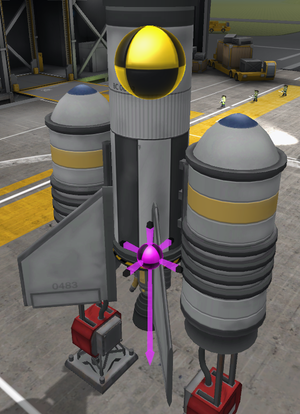Center of thrust
The center of thrust (abbreviated COT) is the direction in which a craft's thrust is acting and the point at which the overall thrust is effectively acting. Because it also has a direction component, it's usually called the thrust vector. The thrust vector should point directly toward or directly away from the craft's center of mass, or else the thrust will cause the craft to rotate (some of the force of the thrust will cause a torque). Such torque can sometimes be balanced out by control surfaces, RCS, reaction wheels, or other additional torque forces acting on the craft. Although a thrust imbalance can be counteracted, it is more fuel efficient to make a balanced rocket with its COM in-line with its COT.
It is important to note that the COT depends on all running engines on the craft, and not just the engines in any individual stage. The center of thrust will change when any single engine's thrust changes due to activation, throttling, shutdown, or any other change. This includes when a craft's configuration changes due to jettisoning an engine or docking with another craft that has an active engine.
The center of thrust is one of the three “centers” displayed in the VAB and Spaceplane Hangar along with the center of lift and center of mass, abbreviated COL and COM respectively.
Pendulum rocket fallacy
It is tempting to think about placing the engines of a rocket at the top, so that the thrust vector points down toward the center of mass. This way, it seems that the engines will pull the rocket up, and that the rocket's weight will keep it hanging directly under the engines, so that it stays upright. Unfortunately, this is not true. Since the rocket's weight acts as a force exactly through its center of mass, gravity doesn't provide any torque to oppose the rotation of the rocket. Any imperfection in the alignment of the thrust vector, or any outside torques, will still cause rotation. This is equally problematic regardless of the location of the engines. The stability of a rocket ultimately depends on its ability to actively counteract imperfections. In KSP, this is most often accomplished by using engines with thrust vectoring. When such an engine gimbals, it slightly modifies the thrust vector. SAS uses this as needed to correct for imbalances, along with RCS, reaction wheels, and control surfaces.
A highly unbalanced rocket (e.g. a rocket that loses one of multiple engines due to rapid unplanned disassembly) might produce so much torque at full throttle that its other controls are too weak to prevent it from rotating. This means it will be mostly uncontrollable. It might be possible, however, to control such a craft by throttling the engines down to a point where the torque they produce is no greater than the torque from SAS.
See also
- Center of lift
- Center of mass
- Pendulum rocket fallacy on Wikipedia
